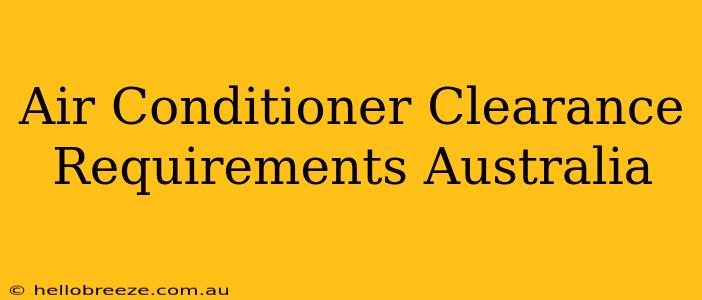Buying a new air conditioner is a big decision, especially in Australia's diverse climate. But before you even think about the best brand or features, you need to understand the crucial aspect of air conditioner clearance requirements in Australia. Failing to meet these requirements can impact your warranty, efficiency, and even safety. This guide will break down everything you need to know about clearances for your new split system or ducted air conditioner.
Understanding Air Conditioner Clearance Needs
The minimum clearances for your air conditioner are not arbitrary; they are essential for several reasons:
- Efficient Operation: Proper clearances ensure optimal airflow, allowing your AC unit to work efficiently and effectively cool your space. Insufficient space can restrict airflow, leading to reduced cooling capacity, increased energy consumption, and potential damage to the unit.
- Safety: Adequate clearances prevent overheating and potential fire hazards. Restricted airflow can cause components to overheat, potentially leading to serious safety issues.
- Warranty Validity: Most air conditioner manufacturers stipulate specific clearance requirements. Failing to adhere to these requirements could invalidate your warranty, leaving you responsible for costly repairs.
Key Clearance Areas: Inside & Outside Units
Clearances are required for both the indoor and outdoor units of your split system air conditioner. Let's break down each:
Indoor Unit Clearances
The indoor unit (evaporator) needs space around it for several reasons. Key areas to consider include:
- Top Clearance: This is crucial for easy access for maintenance and cleaning of the unit’s filters. Manufacturers generally recommend a minimum clearance of 300mm above the unit.
- Side Clearance: Allow enough space on either side of the unit for airflow and maintenance access. A minimum of 150mm on each side is typically recommended.
- Front Clearance: The front of the unit should be unobstructed to allow for proper airflow. Manufacturers generally recommend a minimum clearance of 300mm in front.
Important Note: Always check your specific air conditioner's installation manual for precise clearance requirements. These dimensions can vary slightly depending on the model and manufacturer.
Outdoor Unit Clearances
The outdoor unit (condenser) also requires sufficient clearance for efficient operation and safety. Key areas to consider are:
- Top Clearance: Similar to the indoor unit, adequate top clearance is important for maintenance access. A minimum of 300mm is often recommended.
- Side Clearance: Ensure adequate space on both sides of the outdoor unit to allow for air circulation. A minimum of 150mm on each side is generally recommended.
- Front and Rear Clearance: Sufficient space should be provided in front and behind the outdoor unit for unobstructed airflow. The recommended minimum clearances vary depending on the model and size of the outdoor unit but generally require at least 1-2 meters around the unit. This is particularly important to prevent overheating.
- Obstructions: Avoid placing the outdoor unit near any obstructions that could restrict airflow, such as fences, walls, vegetation (bushes, trees, etc.), or other equipment. This can significantly impact performance and safety.
Factors Influencing Clearance Requirements
Several factors influence the exact clearance requirements for your air conditioner:
- Air Conditioner Size: Larger units typically require more clearance than smaller units.
- Manufacturer Specifications: Always consult your air conditioner’s installation manual for the most accurate and manufacturer-specified clearance requirements.
- Local Regulations: In some cases, local building codes might dictate minimum clearances, particularly in apartment buildings or strata complexes.
Consequences of Insufficient Clearances
Ignoring air conditioner clearance requirements can have serious consequences, including:
- Reduced Cooling Capacity: Restricted airflow leads to inefficient operation, meaning your air conditioner won't cool your space effectively.
- Increased Energy Consumption: Inefficient operation translates to higher electricity bills.
- Overheating and Damage: Overheating can damage internal components, leading to costly repairs or even complete unit failure.
- Warranty Invalidation: Many manufacturers will void your warranty if installation doesn't meet their specified clearance requirements.
- Safety Hazards: Overheating can potentially lead to fire hazards.
Conclusion
Understanding and adhering to Australian air conditioner clearance requirements is crucial for the efficient, safe, and long-lasting performance of your air conditioning system. Always consult your air conditioner's installation manual and consider contacting a qualified HVAC technician to ensure your installation complies with all relevant regulations and recommendations. A small investment in proper installation can save you money and headaches in the long run.

